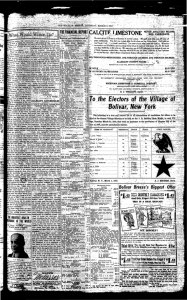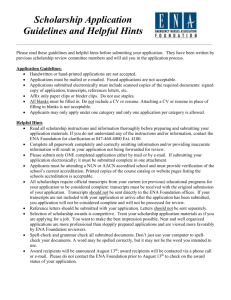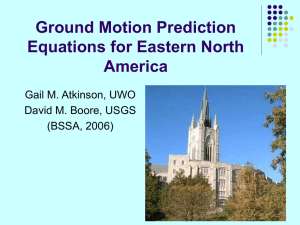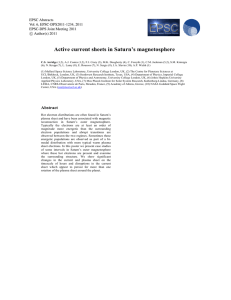UPDATE ON GLOBAL IMAGING USING
advertisement
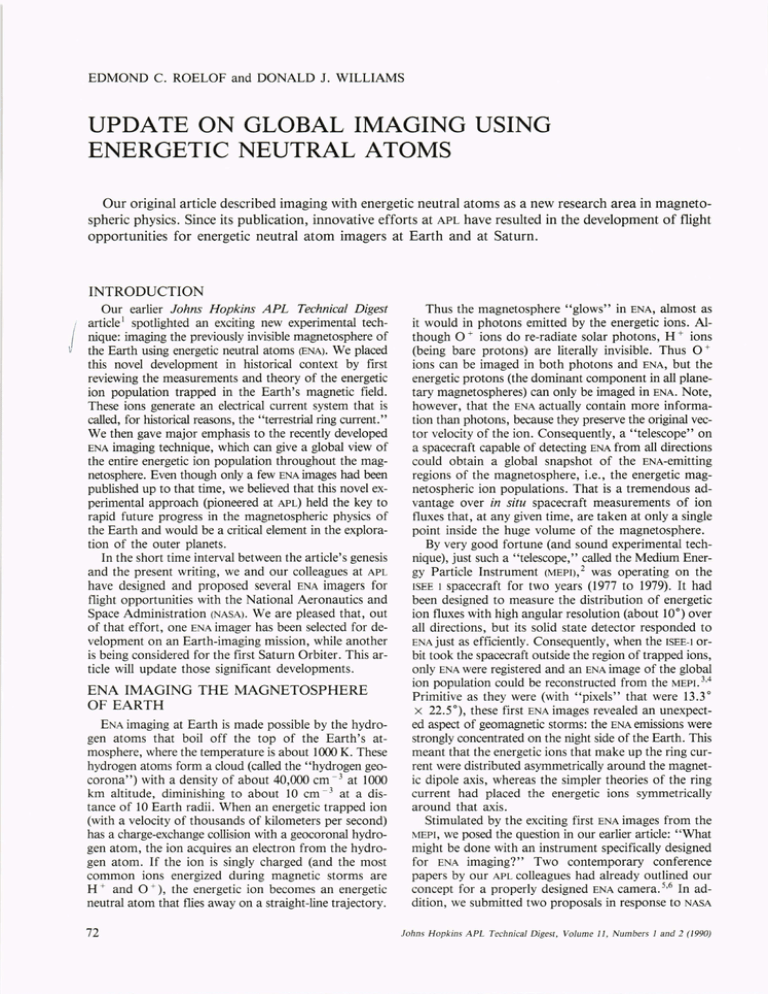
EDMOND C. ROELOF and DONALD J. WILLIAMS UPDATE ON GLOBAL IMAGING USING ENERGETIC NEUTRAL ATOMS Our original article described imaging with energetic neutral atoms as a new research area in magnetospheric physics. Since its publication, innovative efforts at APL have resulted in the development of flight opportunities for energetic neutral atom imagers at Earth and at Saturn. INTRODUCTION Our earlier Johns Hopkins APL Technical Digest article I spotlighted an exciting new experimental tech( nique: imaging the previously invisible magnetosphere of ~ the Earth using energetic neutral atoms (ENA). We placed this novel development in historical context by first reviewing the measurements and theory of the energetic ion population trapped in the Earth's magnetic field. These ions generate an electrical current system that is called, for historical reasons, the "terrestrial ring current." We then gave major emphasis to the recently developed ENA imaging technique, which can give a global view of the entire energetic ion population throughout the magnetosphere. Even though only a few ENA images had been published up to that time, we believed that this novel experimental approach (pioneered at APL) held the key to rapid future progress in the magnetospheric physics of the Earth and would be a critical element in the exploration of the outer planets. In the short time interval between the article's genesis and the present writing, we and our colleagues at APL have designed and proposed several ENA imagers for flight opportunities with the National Aeronautics and Space Administration (NASA). We are pleased that, out of that effort, one ENA imager has been selected for development on an Earth-imaging mission, while another is being considered for the first Saturn Orbiter. This article will update those significant developments. ENA IMAGING THE MAGNETOSPHERE OF EARTH ENA imaging at Earth is made possible by the hydrogen atoms that boil off the top of the Earth's atmosphere, where the temperature is about 1000 K. These hydrogen atoms form a cloud (called the "hydrogen geocorona") with a density of about 40,000 cm - 3 at 1000 km altitude, diminishing to about 10 cm - 3 at a distance of 10 Earth radii. When an energetic trapped ion (with a velocity of thousands of kilometers per second) has a charge-exchange collision with a geocoronal hydrogen atom, the ion acquires an electron from the hydrogen atom. If the ion is singly charged (and the most common ions energized during magnetic storms are H + and 0 +), the energetic ion becomes an energetic neutral atom that flies away on a straight-line trajectory. 72 Thus the magnetosphere "glows" in ENA, almost as it would in photons emitted by the energetic ions. Although 0 + ions do re-radiate solar photons, H + ions (being bare protons) are literally invisible. Thus 0 + ions can be imaged in both photons and ENA, but the energetic protons (the dominant component in all planetary magneto spheres) can only be imaged in ENA. Note, however, that the ENA actually contain more information than photons, because they preserve the original vector velocity of the ion. Consequently, a "telescope" on a spacecraft capable of detecting ENA from all directions could obtain a global snapshot of the ENA-emitting regions of the magnetosphere, i.e., the energetic magnetospheric ion populations. That is a tremendous advantage over in situ spacecraft measurements of ion fluxes that, at any given time, are taken at only a single point inside the huge volume of the magnetosphere. By very good fortune (and sound experimental technique), just such a "telescope," called the Medium Energy Particle Instrument (MEPI),2 was operating on the ISEE I spacecraft for two years (1977 to 1979). It had been designed to measure the distribution of energetic ion fluxes with high angular resolution (about 10°) over all directions, but its solid state detector responded to ENA just as efficiently. Consequently, when the ISEE-l orbit took the spacecraft outside the region of trapped ions, only ENA were registered and an ENA image of the global ion population could be reconstructed from the MEPI. 3,4 Primitive as they were (with "pixels" that were 13.3 ° x 22.5°), these first ENA images revealed an unexpected aspect of geomagnetic storms: the ENA emissions were strongly concentrated on the night side of the Earth. This meant that the energetic ions that make up the ring current were distributed asymmetrically around the magnetic dipole axis, whereas the simpler theories of the ring current had placed the energetic ions symmetrically around that axis. Stimulated by the exciting first ENA images from the MEPI, we posed the question in our earlier article: "What might be done with an instrument specifically designed for ENA imaging?" Two contemporary conference papers by our APL colleagues had already outlined our concept for a properly designed ENA camera. 5,6 In addition, we submitted two proposals in response to NASA fohn s Hopkin s APL Technical Digest, Volume 11, Numbers 1 and 2 (1990) Explorer satellite opporturutles. Our teams proposed imaging from strategically chosen high-apogee, high-latitude orbits. Although these proposals were not selected (we consoled ourselves with the thought that we were "ahead of our time"), we were nevertheless well positioned to respond again when NASA announced the opportunity to fly "secondary science" experiments on the polar-orbiting Earth Observing System (EOS) that would be launched in 1997 to complement the Space Station. Our APL team-Barry H. Mauk (Principal Investigator), Richard W. McEntire, Edwin P. Keath, Donald G. Mitchell, and Edmond C. Roelof-and Brian A. Tinsley of the University of Texas at Dallas proposed the ENA Camera for the Earth-Orbiting satellite (ENACEOS), which was selected for the Phase A definition study. The team was kept small and young, because the EOS prime mission will last for 15 years-until 2012 (even if there is no schedule slippage)! While the bulk of the experiments on EOS will view the Earth from the nadir of the large science platform (3.5 x 7.5 m), we asked to piggy-back on the zenith surface, so we could look upward from the 700-kmaltitude orbit, and thus scan the entire magnetosphere in ENA every 100 min. Figure 1 is the frontispiece from our successful proposal, showing the EOS Polar Platform and a mock-up of the ENACEOS against a false-color, computer-simulated ENA image (lOx 1 angular resolution) of the energetic ion distribution as viewed from 1400-km altitude (twice the altitude of the EOS Polar Platform orbit), and 15 from the South Magnetic Pole. Regular readers of the Technical Digest may recall that the same ENA image was presented on the cover of the issue in which our article appeared. 1 The scanning of the magnetosphere by the ENACEOS provides sufficient information on each orbit to synthesize quantitatively the global topology of the energetic ion populations. It scans the magnetosphere, however, from the inside to the outside. The situation is depicted in Figure 2A. The inset shows the plane of the EOS Polar Platform orbit (days ide equator-crossing at 1330 local time) with a stylized ENACEOS instrument looking upward as the spacecraft is just emerging from the northern polar cap. The mam part of the figure is a view from 10,000 km above the Polar Platform. Dipole magnetic field lines that cross the magnetic equator at L = 3 and L = 5 earth radii are drawn in the noon-midnight and dawn-dusk meridians. The false-color computergenerated image (using the ring-current ion distribution derived from a published ISEE-J image of an actual geomagnetic storm), gives the ENA fluxes during a typical geomagnetic storm as they would be imaged looking earthward from this 10,OOO-km altitude. An ENA image from such a vantage point is relatively easy to interpret, but the ENACEOS images, looking upward from 700-km altitude, require more sophisticated processing to unfold the global energetic ion distribution. To further complicated matters, the instrument's view is restricted to 90 slices of the sky through three sets of electrostatically charged plates (Fig. 2B) that exclude electrons and ions at the same time that they collimate the ENA'S into ENA 0 0 0 Johns Hopkins APL Technical Digest, Volume I1, Numbers J and 2 (1990) Figure 1. Frontispiece from the successful proposal for an imaging experiment on the planned NASA Earth Observing System Polar Orbiting Platform. This false-color, computersimulated ENA image of trapped magnetospheric ions appeared on the cover of the Johns Hopkins APL Technical Digest, Volume 9, Number 2 (1988). ENA 0 0 3 x 90 fans. The combined viewing capability of the three fans is diagrammed in Figure 2C. Since the EOS platform is a three-axis stabilized spacecraft, we make use of the orbital motion to obtain a c0mplete scan every 100 min. Then techniques akin to that of tomography (well-known in medical procedures such as "CAT [computer-aided tomography] scans") can reconstruct the ion distribution of the ring current in three dimensions. This straightforward approach must be modified if there are significant variations in the ion distribution on time scales less than 100 min, such as magnetic substorms. Consequently, we also included on the ENACEOS the capability to detect rapid time variations, as we will explain in the following paragraphs. The view in ENA of the zenith hemisphere from the polar-orbiting platform (at the position shown in Fig. 2A) would appear as in Figure 2D; the white lines are magnetic field lines that cross the magnetic equator at L = 3 and L = 5 drawn every 3 h of magnetic local time (L is the equatorial radial distance, in Earth radii, to the magnetic field line through the spacecraft). Therefore, the edge of the white oval is recognizable as the northernmost extent of the L = 5 shell as viewed from the EOS platform. The ENACEOS collects only the pixels in the three fans ("forward," "dawn," and "dusk") whose locations are superimposed as thick black lines in Figure 2D. The ENACEOS does not contain a rearward fan, because the information it supplies is nearly equivalent to that from the forward fan as long as the ENA 73 E. C. Roe/of and D. J. Williams B Dusk cross-orbit fans Dawn cross-orbit fans o Cross-orbit dusk Cross-orbit dawn Figure 2. ENA imaging of the Earth's magnetosphere from the planned NASA EOS Polar Orbiting Platform, using the ENACEOS cam era. A. The EOS orbit (inset) and the spacecraft position (just exiting the polar cap) superimposed on an ENA image of the trapped energetic ion population. B. The fan-shaped collimators of ENACEOS, with charged-particle rejection voltages applied, form ENA images of crossed slices of the zenith hemisphere. C. ENACEOS combined coverage of the zenith hemisphere. D. ENACEOS coverage (black lines) projected on a computer-generated ENA image of the zenith hemisphere (viewed from the orbital position shown in A). fluxes do not evolve significantly over a single IOO-min orbit of the EOS Polar Platform. In disturbed times during magnetic storms, however, the forward fan will identify evolving ENA fluxes, because a given region of the magnetosphere remains in its field of view for up to a quarter of an orbit (25 min). The EOS polar platform orbit offers a valuable additional opportunity for studying energetic magnetospheric ions. The same ion population that generates the ENA image also contains a subpopulation that precipitates out of the magnetosphere during disturbed conditions and spirals down to the EOS orbit along high latitutude magnetic field lines, allowing a direct comparison of ENA and ion composition and energy spectra. For that reason, one pair of collimator plates in each of the collimated fans of the ENACEOS head does not have a charged-particle 74 rejection voltage applied, so that it can measure the energy, composition, and pitch-angle distributions of the ions precipitating from the same population that is being simultaneously globally imaged by the fans that do have the charged-particle rejection voltage applied. We believe the "inside-out" ENA images of the magnetosphere will provide a real-time, orbit-by-orbit characterization of the global state of the magnetospheric energetic ion population and the deposition rate of energy into the upper atmosphere. The ENACEOS will produce a novel data set for the analysis of the problem of magnetospheric/ionospheric/atmospheric coupling. There should be plenty of time during the I5-year EOS mission to investigate in great scientific detail the wealth of energy and compositional information acquired on every orbit for both ENA and precipitating ions. Johns Hopkins APL Technical Digest, Volume 11, Numbers J and 2 (1990) The Terrestrial Ring Current ENA IMAGING OF THE MAGNETOSPHERE OF SATURN We ended our 1985 "discovery" article on ENA imaging 3 with the prediction: "We believe these novel quantitative results and the technique of 'imaging' ENA emission offer a potential new research tool for the study of global magnetospheric dynamics from spacecraft orbits around the Earth-or around the giant planets of our solar system." Three years later, Hsieh and Curtis 7 used a computer simulation to demonstrate that ENA imaging was feasible at Saturn. This line of advocacy was carried forward by our APL colleagues 8 and our team was funded by NASA for instrumentation development aimed at an ENA imaging capability for the forthcoming NASA/ ESA (European Space Agency) Cassini OrbiterIProbe mission to Saturn. When the Announcement of Opportunity for Cassini was issued at the end of 1989, we formed an international team of 17 members, with Stamatios M. Krimigis of APL as Principal Investigator, to propose an integrated Magnetospheric Imaging Instrument. That instrument combines an ENA camera (for global imaging of Saturn's giant magnetosphere) with energetic ion and electron detectors (for in situ measurements of energetic particle fluxes, pitch-angle distributions, chemical composition, and charge state). Saturn's magnetosphere is immense. It extends outward to 20 Rs (where Rs = Saturn radius = 60,000 km) on the dayside, whereas the Earth's dayside magnetopause is usually found at 12 R£ (where R£ = Earth radius = 6370 km). That means that the Saturnian system is more than 15 times larger. When the Cassini Orbiter has its periapsis at 50 Rs, the orbital period will be close to 2 months. The large size and long duration of the Cassini orbit make global imaging the natural research tool for this mission. In addition, there is a fascinating aspect of the Saturn system that only global imaging can exploit. That is the presence of the great moon Titan, unique in that it is a mini-planet with its own atmosphere. The H2 molecules that boil off Titan's outer atmosphere form a "torus" of cold neutrals along Titan's orbit at 20 R s. Hydrogen also boils off the exosphere of Saturn itself, just as it does at Earth, but, unlike Earth, the Titan torus forms another source of cold neutrals in the outer magnetosphere. The interesting consequences for ENA imaging of Titan's atmosphere and torus are illustrated in Figure 3. Mathematical models of the energetic ion and neutral hydrogen distributions were developed based on particle and extreme-ultraviolet (Lyman-a) observations taken during the Saturn fly-bys by the Voyager 1 and 2 spacecraft in 1980 and 1981. These models were then used to generate ENA images as they would appear along the proposed Cassini Orbiter trajectory during its tour of the planet's magnetosphere (beginning in the year 2003). Figure 3A shows an ENA image from 5.9 Rs and 55° magnetic latitude. Comparison with Figure 2A (which views Earth from almost the same latitude), reveals how the Titan torus could extend the visibility of the energetic ion population out to the limits of the Saturn magnetosphere. Johns Hopkin s APL Technical Digest, Volume 11 , Numbers I and 2 (1990) A " .' 8 Log Log (max) (maxl100) Figure 3. Computer-generated ENA images of Saturn 's magnetosphere in 100 fish-eye projection. They show the relationship of (A) the ENA image to (8) the line-of-sight integrated energetic ion fluxes and to (C) the cold neutral atom column density. Titan is a significant source of cold H2 molecules, as shown in C, and thus its extended atmosphere and torus also appear in the ENA image, A. 0 Even Titan's local exosphere may be identifiable in an image. ENA images of the Saturn system would there- ENA 75 E. C. Roelof and D. J. Williams fore contain valuable information on both the energetic ions and the cold neutrals. This is can be demonstrated by generating images (from the same vantage point) of the line-of-sight integrated energetic ion flux (see Fig. 3B), as well as an image of the cold neutral column density (see Fig. 3C). The intense Saturnian ring current is evident in Figure 3B, while Titan and its torus appear in the column densities of Figure 3C. The unfolding of these two distributions from the ENA image (Fig. 3A) will be aided greatly by the ground truth gained from the in situ energetic ion detectors when the orbiter traverses the ring current itself. Ground truth is also obtained on the exosphere of Titan during the many close encounters (Woo-km altitude) in which the moon's gravitational field is used to "crank" the orbiter from its initial nearequatorial orbits up to near-polar orbits (excellent for imaging) near the end of the mission. These many fly-bys will calibrate the Titan exosphere (using extreme ultraviolet and ENA images), so that Titan becomes a "standard candle" in the ENA images (such as Fig. 3A). The details of Figure 3 may be speculative (albeit based on our best information from the Voyager fly-bys), but the global characteristics of the computer-generated images suggest the exciting range of phenomena that could be revealed by ENA imaging at Saturn. THE AUTHORS EDMOND C. ROELOF received his Ph.D. in physics from the University of California, Berkeley, in 1966. Dr. Roelof then was a research scientist at the Boeing Scientific Research Laboratories in Seattle and at NASA/Goddard Space Flight Center and an Assistant Professor of Physics at the University of New Hampshire before joining APL'S Space Physics and Instrumentation Group in 1974. He has held visiting appointments at NOAA'S Space Environment Laboratory in Boulder, Colorado, as well as at universities and institutes in The Netherlands, the Federal Republic of Germany, and France. He has served on NASA Management and Operations Working groups and as an officer of the American Geophysical Union, from which he received the 1987 Editor's Citation for Excellence in Refereeing (Geophysical Research Letters). His published research covers topics in energetic particles, plasma, magnetic fields, and radio emissions in the solar corona, the interplanetary medium, and the magnetospheres of Earth, Jupiter, and Saturn. Dr. Roelof will continue these investigations through the 1990s as a co-investigator with the APL experimenter teams on the Ulysses (heliosphere), Galileo (Jupiter), and ISTP (Geotail) missions. SUMMARY Our earlier article 1 concluded with this sentence: "ENA imaging as a tool for understanding the morphology and dynamics of the global ion population is clearly just beginning to reveal its full potential." Scarcely two years later, APL is designing the first ENA camera selected by ASA for possible flight, and an APL-Ied international team has just proposed a similar ENA camera for the exploration of Saturn-Titan ion-neutral system on the Cassini Orbiter, planned to enter orbit around Saturn sometime after the year 2000. REFERENCES c., and Williams, D. J. , "The Terrestrial Ring Current : From in situ Measurements to Global Images Using Energetic Neutral Atoms," Johns Hopkins A PL Tech. Dig. 9, 144-163 (1988) . 2 W illiams, D. J ., Keppler, E. , Fritz, T . A. , Wilken , B., and Wibberenz, G ., " The ISEE I a nd 2 Medium Energy Particles Experiment," IEEE Trans. Ceosci. Electron. GE-16, 270- 280 (1978). 3 Roelof, E. c., Mitchell, D. G ., and Williams, D . J., "Energetic Neutral Atoms (E - 50 keV) from the Ring Current: IMP 7/ 8 and ISEE I ," J. Ceophys. Res. 90, 10,991 - 11 ,008 (1985). I Roelof, E . Roelof, E. c., " Energetic Neutral Atom Image of the Storm-Time Ring Current," Ceophys. Res. Lett. 14, 652-655 (1987). 5 Keath , E. P ., Andrews, G . B., Mauk , B. H ., and Williams, D . J ., " Instrumentation fo r Energetic eutral Atom Imaging of Magnetospheres, " in Solar System Plasma Physics, Geophysical Monograph 54, American Geophysical Union, Washington, D .C., 165- 170 (1989). 6 McEntire, R. W., and Mitchell, D. G. , " Instrumentation and Imaging of Energetic eutral A toms," in Solar System Plasma Physics, Geophysical Monograph 54 , American Geo phy ical U nion , Washington , D.C., 69-80 (1989) . 7 Hsieh , K. c., a nd Cu rt is, C. c., " A Model for the Spatial and Energy Distributions o f Energetic eutral Atoms P roduced within the Saturn/ Titan Plasma System ," Ceophys. Res. Lett. 15, 772- 775 (1988). 8 Cheng, A. F., and Krimigis, S. M. , " Energetic Neutral Particle Imaging of Saturn 's Magnetosphere," in Solar System Plasma Physics, Geophysical Monograph 54, American Geophysical Union , Washington, D.C. , 253-260 (1989). 4 76 DONALD J. WILLIAMS received a B.S. degree in physics from Yale University in 1955 and, after two years in the Air Force, received M.S. and Ph.D . degrees in nuclear physics, also from Yale University, in 1958 and 1962, respectively. He joined APL'S Space Department in 1961, where he participated in developing APL'S early space research activities. In 1965 he went to NASA/Goddard Space Flight Center, where he headed the Particle Physics Branch. In 1970 he was appointed Director of NOAA'S Space Environment Laboratory in Boulder, Colorado, where he remained until 1982 when he rejoined APL'S Space Department. Dr. Williams has been principal investigator, project scientist, and co-investigator for a variety of ASA, NOAA, DoD, and European satellite programs. His research activities are in the field of space plasma physics with emphasis on planetary magnetospheres. He has served on several national and international planning and advisory committees on space plasma physics and is Vice President of the International Association of Geophysics and Aeronomy. He is also principal investigator for the energetic particle detector on NASA'S Galileo spacecraft launched in October 1989 and now en route to Jupiter, and the energetic particle and ion composition experiment on the Japanese/ NASA Geotail satellite which will be launched into the earth's magnetotail regions in July 1992. Dr. Williams, until recently Branch Chief of the Space Sciences Branch in the Space Department, is currently Director of the Milton S. Eisenhower Research Center at APL. fohn s Hopkin s APL Technical Digest, Volume 11, Numbers J and 2 (1990)

